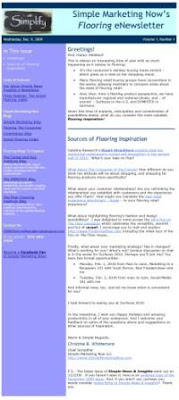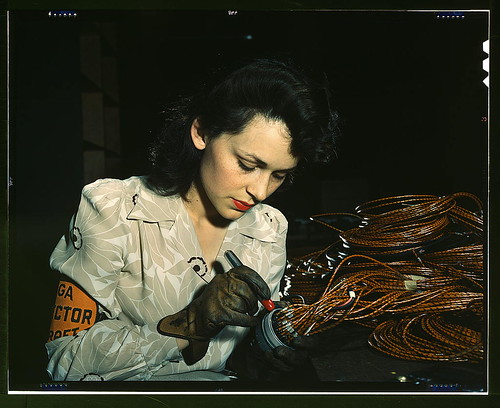
Are you familiar with BuildDirect and BuildDirect President & CEO Jeff Booth?
He and
co-founder Rob Banks, launched BuildDirect in 1999, building it into "
the world's leading online manufacturer-wholesaler of flooring & building materials." Not only have they
satisfied customers in Canada, but also in every state in the U.S. plus over 60 countries around the globe.
How? With a
different flooring business model and a strong commitment to customer service, transparency, authenticity and integrity.
You'll notice BuildDirect prominently featured in the
Social Flooring Index. They actively participate in social media marketing tools with
Twitter,
Facebook and
blogs and have integrated the tools into their overall business. In other words, they are
Flooring It Differently with social media!
Jeff Booth, BuildDirect President & CEO, shares his insights in the following interview.
C.B.: Jeff, tell me about yourself and your company, BuildDirect.
BuildDirect is an online building materials firm, founded in 1999 by myself and my friend and business partner Rob Banks. We’re both interested in how technology impacts business, so we looked at the Internet as the best way to make the traditional international building materials supply chain more efficient, since the Internet is international by its very nature. Coupled with traditional business values of good communications and customer service, we’ve achieved a good balance between efficiency, and customer relationship management.
C.B.: How did you get involved in flooring?
I was involved in the construction industry before I started the company and had many contacts in the field. The thing that tipped me off about flooring was how much markup there was on these items, along with other building materials used in construction projects. I wanted to devise a way to get flooring products into the customer’s hands without those markups. And with my understanding the potential of Internet technology, and by developing a system to manage the logistics side of things, that really made the difference in my approach to marketing our flooring products
C.B.: How did you get involved in social media?
We’re always looking to make deeper connections with customers, to identify what their needs are and how we as a company can meet them. Early on, we incorporated unedited customer product reviews on our site, and began developing a blogging presence, too. It seemed to me at the time that we as a company needed to do more to connect with site visitors, and with our peers in the construction industry.
And in closely following how Barack Obama connected with the American people directly while using social media platforms during his Presidential campaign last year, I was inspired to follow in the spirit of that. I did so by approaching social media as a means of connecting with and learning from other people, and responding authentically. My team and I started to build a vision of success in social media based on that kind direct interaction. After that, we started a Twitter account for the company; I started my own Twitter account, and we expanded our social media presence on Facebook, on YouTube, and in many other social arenas. The results have been encouraging, and we’ve made a lot of friends, and sales, that perhaps we wouldn’t have made otherwise.
C.B.: How do you personally and your organization use social media for business?
Two key precepts with social media are transparency and authenticity. It’s about adding value, and providing practical information to an audience with these precepts at the forefront. Since many of these principles have been a part of our core values as a company since we started, getting involved in developing a social media presence along these same lines just seemed to make sense to me, and to many of our staff, too. And another aspect has been that old idea of ‘word of mouth’, which had served us very well before many of these social media platforms came along. But, with Twitter and Facebook, for instance, the potential word of mouth equity is increased exponentially.
And where we do use social media as a means of directly promoting products, we also use it as a way of forming community with our peers. This also includes some of our competitors, some of whom also do great work in providing practical value. To the customer’s benefit, it makes sense for us to get involved in that, in sharing information even if it doesn’t come from us. Many people then begin to know who we are and what we’re about on a level that wasn’t possible before. So, when it comes time to talk about buying floors from us, it’s just a natural progression that comes out of a growing relationship with them, based on how helpful we’ve been in the past without expecting a sale.

C.B.: What do you like most and least about flooring?
Quality flooring represents a range of products that I believe adds value to the lives of pretty much everyone. In this, developing a way of getting the best of it to customers for less money is very rewarding. Getting that feedback from customers who tell us about how pleased they are with their orders, both in terms of the high quality and the lower price is a definite signpost that we’re doing good work.
I suppose the thing about it which is the most challenging is changing people’s perceptions about quality against price. Because there are so many factors that affect product quality across multiple product lines, it has been historically difficult for customers to get a real apples-to-apples comparison industry-wide. When customers see a ticket price, there are often a lot of hidden factors there that affect it which is kept from them, in many cases. And this can lead to rash purchases that cost them later on. The real challenge for us is to bring our customers and buyers in general into a place where they’re getting a true picture of how flooring and other building materials should be compared before a purchase is made. This is another arena where transparency is so important. In some ways, making the sale is much like conducting oneself in social media; it should be an honest dialogue about what is the best way for customers to make an investment in their flooring project that saves them money in the short term, but also leads to a good return on their investment in the long term.
C.B.: What suggestions do you have for improving the flooring retail experience?
I think vendors who really know their stuff, and who are interested in taking the time to educate their customers when needed are the real superstars in our industry. Flooring is a long-term purchase. Making sure that the customer has all of the facts, and in turn increasing the chances that the customer is going to be happy with their purchases for years to come, is the best way of proving credibility for those vendors. By extension, it proves credibility for the industry too.
C.B.: What do you like most and least about social media?
Our purpose as a company is to transform our industry, by making the products more accessible, more affordable, and with a higher standard of quality across the board. The best way to do that is direct engagement with partners and peers, with influencers in the media, and with customers and industry professionals. Social media in this respect is invaluable. It helps us to focus our purpose on creating community, dialogue, and learning opportunities in order to bring about a vision for ourselves and our industry that we set in place since we began the company. This is the kind of potential that excites me the most about the possibilities that social media platforms present.
I suppose the drawback to social media is that everyone is invited to the party, some of whom aren’t as transparent as others. Information and motives therefore must always be questioned. Yet, at the same time this is true of traditional media too, although without the chance to talk back. It’s a question of discernment. Exercising that skill is pretty important anyway, and there are many opportunities to do so in social media spaces.
C.B.: Is everyone in your business involved on social networks?
Many are, yes. Some aren’t. The real value in social media comes out of honesty and personal passion. It’s always best when people embrace social media in their own time. In our case, involvement has definitely risen over the last year, with some really getting into it, while others are just dipping their toes in the water. Both approaches are valid, as long as what is put out there remains true to personal and company values. Luckily, everyone involved understands that pretty well.
C.B.: How do you manage all of the different channels?
In some ways, the channels are really secondary to the approach. Managing them is a question of providing useful information and by engaging with others on a daily basis. A part of social media is about telling the story of our company, about how we’re getting better everyday, and about how our interactions with others affects how that story goes. And it’s about being prepared to transparently deal with situations when we don’t do a good job, or when people get upset even when we’ve done our best. In this respect, staying true to our core values of respect for others is the key tool in managing our presence online, regardless of which channel it happens to be.
C.B.: What advice do you have for others wanting to get involved with social media for their business?
I have lots of advice!
1.
Be prepared to listen more than talk. After you’ve finished listening, always add value in some way – be helpful.
2.
Ask questions of the experts, once you’ve used your powers of discernment to find out who those experts are (there are a lot of would-be ‘gurus’ out there).
3.
Start a social media presence because you want to build relationships, not sell to customers. The relationships you foster today may result in the customers you sell to tomorrow, but it rarely works the other way around in a social media space.
4.
Find out who in your organization is passionate about social media, and empower them to get involved without trying to control every little aspect of how they do it.
5.
Take risks; show yourself as a person or group of people, not as a brand. Relinquish control over your brand so that your customers have a voice in determining what your brand means based on how you interact with them.
6.
And above all – KEEP IT UP! Social media is a slow road to success, with no silver bullets that you can design or expect. Just stick to your ethics, your values, and to those things which are true to your personality, including passions and interests that may have nothing to do with what you’re trying to sell. Your audience will decide how successful you’ll be based on these factors, not you. That’s the scary part, and the rewarding part at the same time.
Thank you, Jeff!Comments? Questions? Reactions?
How would you apply these insights to your flooring business?
Follow me on
http://twitter.com/cbwhittemore.
Become a
Facebook Fan of Simple Marketing Now.
Subscribe to my Simple News & Insights eNewsletter.















